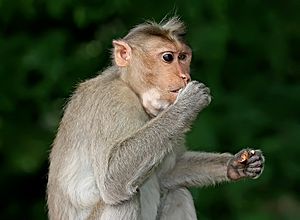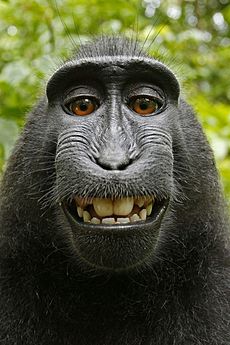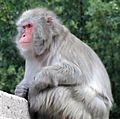Macaque facts for kids
Quick facts for kids Macaques |
|
|---|---|
 |
|
| Crab-eating macaque (Macaca fascicularis) | |
| Scientific classification | |
| Kingdom: | |
| Phylum: | |
| Class: | |
| Order: | |
| Family: | |
| Subfamily: | |
| Genus: |
Macaca
|

Macaques are a type of Old World monkey. They belong to a group called Macaca. There are about 22 different species of macaques. You can find them living in parts of Africa and many places across Asia. One famous type is the 'ape' found in Gibraltar. Macaques are known for their interesting social groups.
Contents
Meet the Macaque Species
There are over 20 different kinds of macaques. Each one looks a bit different and lives in its own special way. Let's explore some of them!
Rhesus Macaque: The Adaptable Monkey
- Rhesus Macaque (Macaca mulatta): This is one of the most famous macaques. You can easily spot them by their reddish-brown fur. Their tail also has a special upward curve. Rhesus macaques are very good at living in many different places. They live across South Asia, including India, Nepal, and China. You might even see them in zoos! There are millions of rhesus macaques in the world.
Japanese Macaque: The Snow Monkey
- Japanese Macaque (Macaca fuscata): These amazing monkeys are also known as Snow Monkeys. They are famous for living in very cold climates. They even warm up by bathing in hot springs during winter! They live in the mountains of Japan. Their thick, dark brown fur keeps them warm. About 100,000 Japanese macaques are thought to exist.
Barbary Macaque: Africa's Only Macaque
- Barbary Macaque (Macaca sylvanus): This macaque is special because it's the only one found in Africa! They live in the Atlas Mountains of Morocco and Algeria. They have greyish-brown fur. They are a bit smaller than other macaques. Sadly, their population is threatened. There are only about 8,000 left.
Lion-tailed Macaque: The Mane Attraction
- Lion-tailed Macaque (Macaca silenus): This beautiful macaque lives in the Western Ghats mountains of southern India. It's easy to spot them by the long, dark mane of hair around their face. It looks just like a lion's mane! That's how they got their name. These macaques are critically endangered. There are only a few thousand left.
Pig-tailed Macaque: Smart and Skilled
- Pig-tailed Macaque (Macaca nemestrina): This macaque gets its name from its unique, pig-like tail. They live in Southeast Asia. They are known for being very smart. They can even be trained for different tasks. It's hard to know their exact numbers. However, they are not currently considered endangered.
Behavior and Social Life
Macaques are very social animals. They live in complex groups. These groups can have a few monkeys or even more than 100! The size depends on the type of macaque and how much food is available.
Group Rules and Intelligence
Within a macaque group, there is a strict social hierarchy. This means some monkeys are more important than others. Dominant macaques get to eat first and have more choices for mates. They show who is in charge by being a bit aggressive. But they also bond by grooming each other.
Macaques are also very intelligent. They have been seen using tools to find food. For example, some macaques use stones to crack open nuts. Others use sticks to catch insects. This shows how smart they are!
What Macaques Eat
Macaques eat both plants and animals. Their diet changes depending on where they live. They might eat fruits, leaves, and seeds. They also eat insects and small animals. Sometimes, they even look for human food.
Protecting Macaques
Many macaque species are in danger. This is because their homes are disappearing. They are also hunted, and some are caught for the illegal pet trade. It's very important to protect these amazing animals.
Conservation Efforts
Many groups around the world are working to save macaques. They protect their homes and try to stop poaching. They also teach people about why macaques are important. These animals play a key role in their ecosystems. Their survival helps keep the planet healthy.
Macaques and Humans
Macaques sometimes live close to people. You might even see them in cities. This can sometimes cause problems. Macaques might take crops or food from garbage. They can also become aggressive if they feel scared.
It's important to remember that macaques are wild animals. We should treat them with respect and be careful around them. Never try to get close to or feed a wild macaque.
Images for kids
-
M. fascicularis on a scooter at Ko Chang, Thailand
-
Stump-tailed macaques (M. arctoides)
-
Japanese macaques (M. fuscata) bathing in a hot spring in Nagano
-
A male northern pig-tailed macaque (M. leonina)
-
A crested black macaque (M. nigra)
-
A toque macaque (M. sinica) in Sri Lanka
-
Long-tailed macaques in Malaysia
See also
 In Spanish: Macacos para niños
In Spanish: Macacos para niños










